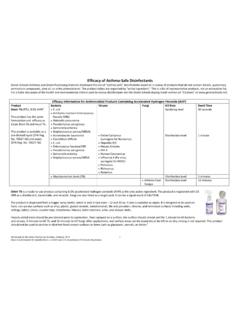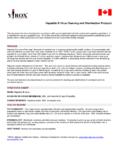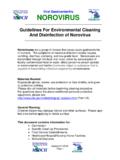Transcription of Food Safety Sample SOP - CCBH
1 Revised 2013 food Safety Sample SOP cleaning and disinfecting Body Fluid Spills PURPOSE: This standard operating procedure (SOP) should be implemented to safely and properly respond to all incidents requiring cleaning and disinfecting of body fluid spills. Body fluids including vomit, diarrhea, and blood are considered potentially infectious. Employees should always wear personal protective equipment when cleaning and disinfecting body fluid spills. PROCEDURES: 1. Contain the affected area Discontinue foodservice operations if spill occurred in food preparation or service areas. Refer to Alternate Meal Service SOP to safely continue meal service. Block off the area of the spill from staff and students until cleanup and disinfection are complete. For incidents involving vomit, contain all areas within 25 feet of the spill.
2 Send sick staff and students to the school clinic/nurse for assistance. Exclude ( , send home) foodservice employees with symptoms of vomiting or diarrhea from foodservice operations. Refer to the food Safety Sample SOP Exclusions and Restrictions for Ill or Infected food Service Employees. Allow only foodservice employees and/or custodial staff designated to clean and disinfect body fluid spills in the affected area. If the spill is in a non-foodservice area, school custodial staff should handle the cleanup. 2. Retrieve the Body Fluid Cleanup Kit. Refer to the food Safety Sample SOP Assembling a Body Fluid Cleanup Kit. 3. Put on personal protective equipment (PPE), including: Disposable, non-latex gloves. Gloves should be vinyl or nitrile (rubber), and non-powdered. Consider double gloving (wearing two gloves on each hand). Replace gloves if they tear or become visibly soiled.
3 Keep hands away from face while wearing gloves. A disposable gown or apron, and disposable shoe covers. A face mask with eye protection, or goggles. 4. Remove visible body fluid Pour sand, or liquid spill absorbent material, on body fluid spill. Use a disposable scoop, or equivalent, and disposable paper towels to remove the sand and body fluid from the affected surfaces. Revised 2013 Dispose of the sand, body fluid, disposable scoop, and paper towels in a plastic garbage bag. Remove gloves. Dispose of gloves in a plastic garbage bag. Wash hands. 5. Clean the affected area Put on new disposable gloves. Consider double gloving. Clean the affected area with soap and water, and paper towels and/or a disposable mop head. This includes surfaces that came into direct contact with body fluids, and surfaces that may have been contaminated with body fluids.
4 Before disinfected, all surfaces should be thoroughly cleaned ( , not visibly soiled). Dispose of the paper towels and/or disposable mop head in a plastic garbage bag. Remove gloves. Dispose of gloves in a plastic garbage bag. Wash hands. 6. Disinfect the affected area Put on new disposable gloves. Consider double gloving. Non-absorbent Surfaces ( , tile, stainless steel) Prepare a chlorine bleach disinfecting solution.* Wear all PPE, including the face mask with eye protection, or goggles. Ensure that area is well ventilated (mix solution outdoors if necessary). Prepare solution immediately before applying it to surfaces using unscented, household bleach ( concentration) and water. Once opened, household bleaches lose their effectiveness after 30 days. Use a new, unopened bottle of bleach every 30 days for preparing solutions. Mix between 5 tablespoons and 25 tablespoons ( cups) of bleach with 1 gallon of water (solution concentration of 1000 5000 parts per million (ppm)) in a bucket designated for chemical use.
5 It is recommended that cups of bleach per 1 gallon of water be used on surfaces that have had direct contact with body fluids. Transfer solution to a spray bottle. Using the spray bottle, generously apply the disinfecting solution to affected surfaces, including surfaces that came into direct contact with body fluids, and surfaces that may have been contaminated with body fluids. For incidents involving vomit, disinfect all areas and surfaces within 25 feet of the spill. Use in a well-ventilated area Revised 2013 Disinfect high touch areas ( , door handles, toilets, dispensers, carts, sink faucets, telephones, etc.) throughout the foodservice area, cafeteria dining areas, break rooms, and restrooms using disinfecting solution and paper towels. Leave the disinfecting solution on affected surfaces for a minimum of 5 minutes.
6 If another EPA-approved disinfectant is used, follow the manufacturer s instructions. Rinse surfaces with clean water, and paper towels and/or a disposable mop head. Allow surfaces to air dry. Dispose of the paper towels and/or disposable mop head in a plastic garbage bag. Remove gloves. Dispose of gloves in a plastic garbage bag. Wash hands. Put on new disposable gloves. Consider double gloving. Dispose of paper towels in a plastic garbage bag. Remove gloves. Dispose of gloves in a plastic garbage bag. Wash hands. * EPA-approved disinfectants may be used instead of chlorine bleach solutions. EPA-approved disinfectants appropriate for vomit and diarrhea may be found at CDC guidelines on norovirus outbreak management and disease prevention recommend using chlorine bleach solutions on hard surfaces when possible. EPA-approved disinfectants appropriate for blood may be found at Absorbent Surfaces ( , carpet, upholstery, cloth) Disinfect with a chemical disinfectant when possible.
7 Steam clean for a minimum of 5 minutes at 170 F. Launder in a mechanical washing machine on the hottest water setting, and dry in a mechanical dryer on a high heat setting. Dispose of disinfecting materials in a plastic garbage bag, as appropriate. Remove gloves. Dispose of gloves in a plastic garbage bag. Wash hands. 7. Discard potentially contaminated food . Put on new disposable gloves. Consider double gloving. Dispose of exposed food and food in containers that may have been contaminated by body fluid in a garbage bag. o For incidents involving vomit, discard all food within 25 feet of the spill. food in intact, sealed containers ( , cans) may be salvaged if adequately cleaned and disinfected. Revised 2013 o Have a second employee, one who is not directly contacting potentially contaminated food , inventory the discarded food in a Damaged or Discarded Product Log.
8 Remove gloves. Dispose of gloves in a plastic garbage bag. Wash hands. 8. Dispose of PPE, and cleaning and disinfecting materials. Put on new disposable gloves. Consider double gloving. Securely tie garbage bags containing all materials disposed of in steps 4-7 of this SOP. Place garbage bags in a second garbage bag (double bag). Clean all non-disposable items (bucket, mop handle, etc) with soap and water; then disinfect. Allow these items to air dry. Remove PPE, including disposable gloves, and place in second garbage bag. Securely tie the second garbage bag. Discard the bag(s) in the disposal area identified by school officials. Remove soiled clothes, if necessary, and place clothes in a separate garbage bag. Securely tie the garbage bag. Keep clothes in the tied garbage bag until they can be adequately laundered. 9. Wash hands, arms and face with soap and water in a restroom sink or hand sink.
9 Put on clean clothing, if necessary. Apply ethanol based hand sanitizer to hands. 10. Wash, rinse, and sanitize potentially contaminated food contact surfaces. Include food contact surfaces that were disinfected in step 6 of this SOP, and food contact surfaces that contained food discarded in step 7 of this SOP. Refer to the food Safety Sample SOP cleaning and Sanitizing food Contact Surfaces. 11. Restock the contents of the Body Fluid Cleanup Kit. 12. Complete an incident report. MONITORING: The foodservice manager will: 1. Ensure that the Body Fluid Cleanup Kit is properly assembled at all times. 2. Ensure that at least one foodservice employee per shift is: Designated and trained to implement this SOP, and Trained in the use of the Body Fluid Cleanup Kit. 3. Ensure that foodservice employees are: Educated on illnesses and symptoms that must be reported to managers. Monitored for signs and symptoms of illness.
10 Revised 2013 CORRECTIVE ACTION: The foodservice manager will: 1. Restock the Body Fluid Cleanup Kit immediately. Replace expired/out-of-date supplies. 2. Retrain designated foodservice employees in application of this SOP, and use of the Body Fluid Cleanup Kit. 3. Retrain/educate foodservice employees in food Safety Sample SOP Exclusions and Restrictions for Ill or Infected food Service Employees. Restrict or exclude ill foodservice employees in accordance with SOPs. VERIFICATION AND RECORD KEEPING: The foodservice manager will: 1. Verify that an incident report was completed. Keep incident report on file for a minimum of one year. 2. Verify that Damaged or Discarded Product Log was completed. Keep log on file for a minimum of one year. 3. Document training sessions for foodservice employees on applicable SOPs using an Employee food Safety Training Record.





